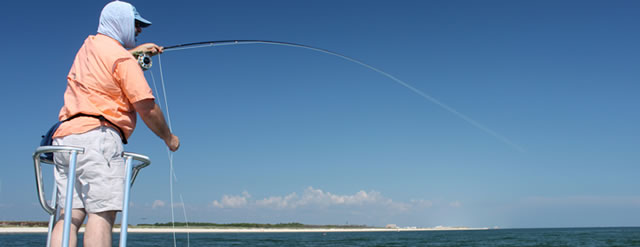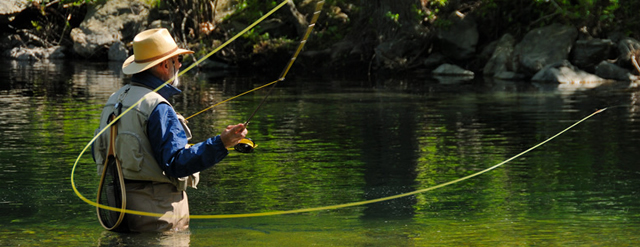Laws of physics govern the process of casting and I refer to them as the principles and variable of casting mechanics.
Principle 1
Tension against the rod tip. Before you can load the rod, you must have line tension against the tip, so that when you move the rod, the weight of the line, aided by water and air resistance, will hold back the tip, causing the rod to load (bend). You can’t load the rod in either direction unless the rod tip is pulling against the weight of the line.
Principle 2
Load and unload the rod. With tension against the tip, the rod is best loaded by a smooth, even acceleration of the hand, producing a constant increase in speed throughout the stroke. The rod unloads when the rod is stopped. An uneven acceleration produces less desirable loops, taken to extreme, tailing loops result. A firm, solid stop unloads the rod just below the oncoming line, producing a tight, narrow loop. A soft stop, moving the rod tip over a longer distance during the stop, results in a wider loop. The more abrupt the stop, the tighter the loop.
Principle 3
The line goes where the rod tip goes — the line can go only in the direction the tip is traveling. If you want the line to go straight ahead, the tip must finish going straight ahead. If you want the line to go farther, the angle of trajectory should be elevated slightly. When casting closer, the finishing point should be lower than the starting point of the cast. In each cast, your target, hence the direction and angle of elevation, may vary.
The 5 Variables in Casting
Hand speed (power), stroke length, casting arc, timing and trajectory are variables casters adjust to achieve a straight-line movement of the rod tip. A short line requires little hand speed, a short casting stroke, narrow casting arc, a short pause (timing) and a forward-tilted trajectory between strokes. A longer line requires more hand speed, longer stroke, wider arc, longer pause and more level-with-the-surface trajectory.
1.Hand Speed – force – rod bend. Adequate hand speed and rod bend is demonstrated when the line has enough energy to straighten at the desired distance, or, the fly reaches its target with the desired shape in the line as in a curve, pile, or ‘S’ cast. With a constant length of line, generally, the amount of power applied on both the back cast and forward cast should be the same. However, shooting line which adds more line (weight) to be cast, and/or differences in wind velocity and direction will ultimately dictate the amount of hand speed needed for each casting stroke.
2.Stroke length. The length of the casting stroke is the distance the hand moves throughout the casting stroke. Generally, this distance varies with the amount of line outside the rod tip – short line, short stroke; longer line, longer stroke.
3.Casting Arc. The V-shaped arc between the rod butt in the start position and the rod butt in the stop position is called the casting arc. This is also described as the angular rotation of the rod through the casting stroke. The caster must adjust the size of the casting arc to fit the amount of bend in the rod to produce a relatively straight-line path of the rod tip to produce a narrow loop. The amount of bend in the rod is determined by:
1) the weight being cast – fly line, leader and fly,
2) the amount of hand speed -force – applied, and
3) the stiffness of the fly rod.
Matching the casting arc size, by bending the wrist or arm more or less, to the amount of hand speed applied (which determines rod bend) is one of the keys to good fly casting. That translates into a narrow arc for short casts and a wider arc for longer casts.
4.Timing. Good timing is demonstrated when the pause between strokes is long enough to allow the line to straighten fully without losing its tension and falling dramatically in the process. Generally we use a short pause for short lines and a longer pause for longer lines.
5.Trajectory. For short lines and close targets the casting arc should be tilted down in front and up in back to maintain a 180 degree rod tip path and a tight, narrow loop that unrolls close to the surface. When casting to more distant targets using longer lines a more upright casting arc is needed. Ideally the fly will unroll just above the target.
The path of the rod tip is a key element of the casting stroke.
If the path of the rod tip is relatively straight throughout the stroke — close to 180 degrees from starting point to stopping point, and you smoothly accelerate the rod to a firm stop, with the rod tip firmly stopping just below the oncoming line, the result will be a tight, narrow loop of line. If the rod tip path is more convex (a doming path – higher in the middle than at each end), a wider loop is the result. If the rod tip path is concave (lower in the middle than each end), a tailing loop will result.
A poor cast results from failure to properly satisfy a principle or execute a variable. On the other hand, the world’s best casters use motions that satisfy the principles and execute variables superbly to achieve a straight movement of the fly line.
Elite casters:
• Straighten line more completely on the back cast with less sag in the line.
• Smoothly accelerate the rod tip along a very straight path.
• Stop the rod abruptly at the end of the casting stroke.
Elite casters, while satisfying the principles and executing the variables superbly, use different styles to achieve the same desirable end results.





